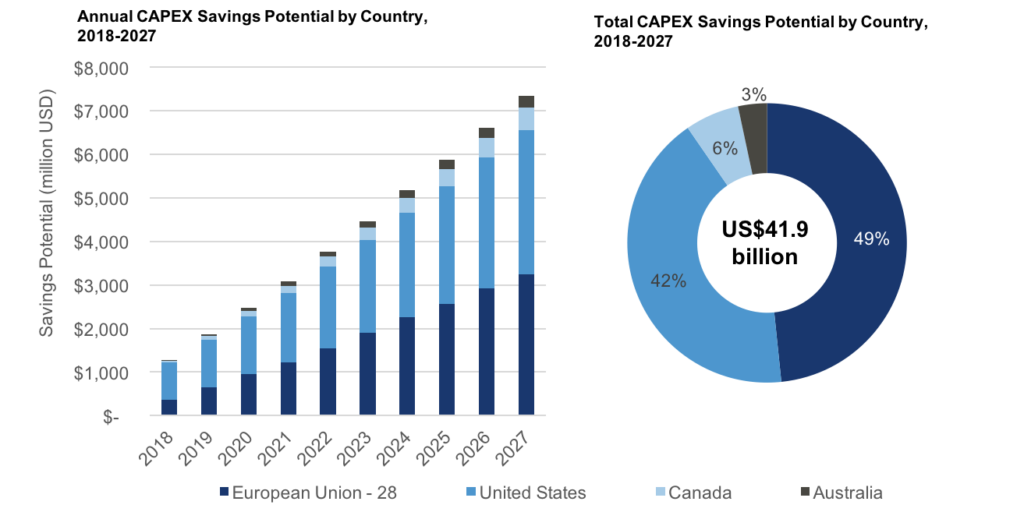Last week, over one hundred U.S. water industry personnel convened in Laurel, Maryland for a workshop to address strategies and trends in modernizing water & wastewater infrastructure. Xylem Inc. brought together representatives from a multitude of public and private municipal water utilities, engineering & consulting firms, and Xylem subsidiaries–Pure Technologies, Visenti, Sensus, and Emnet– to discuss challenges, solutions, and best practices for water infrastructure management.
It is a critical time for water infrastructure, given the convergence of rising infrastructure costs (e.g. material prices, labor, capital), aging collection and distribution networks, and growing demand for water supplies, wastewater treatment, and stormwater management. The challenge is immense, but a variety of solutions are available.
For those unable to attend the event, these are three takeaways that demonstrate some of the key points discussed:
Current estimates of U.S. water infrastructure investment needs fail to account for future innovation. Workshop presenters stressed that utilities’ current budget estimates are based on status quo infrastructure management approaches and technologies, which do not yet reflect the cost-saving potential of emerging and future disruptive solutions, such as trenchless technology, machine learning, IoT, and predictive analytics.
Bluefield’s bottom-up analysis of 100 U.S. cities’ water & wastewater capital improvement plans forecasts more than US$683 billion in CAPEX budgeted for municipal water, wastewater, and stormwater infrastructure nationwide over the next decade. This falls well short of other industry needs analyses that have put the total investment at as much as US$1 trillion. For this reason, we at Bluefield have increased our attention to more advanced asset management and smart water solutions, to track the global deployment and impacts of innovative technologies across the municipal and industrial water verticals.
“…current budget estimates are based on status quo infrastructure management approaches and technologies, [and] do not yet reflect… emerging and future disruptive solutions”
Advanced asset management is emerging as a key area of focus for utilities and solutions providers alike. As municipal utilities face mounting pressure to stretch tight OPEX and CAPEX budgets even further, asset management has come to the forefront as a way to maximize the efficiency of network operations and maintenance. Bluefield projected that advanced asset management solutions will drive as much as US$41.9 billion in CAPEX savings over the next decade in 31 countries in North America, Europe, and Australia. In the context of the Xylem workshop, Bluefield’s forecasts show the United States accounting for 42% of these savings.
Exhibit: CAPEX Savings by Country, 2018-2027 (Annual and Total)
Panelists from the Washington Suburban Sanitary Commission (WSSC) drove home the cost-saving potential of asset management from a utility perspective, noting that their US$122 million prestressed concrete cylinder pipe (PCCP) assessment and maintenance program has avoided 20 pipe failures and up to US$2 billion in replacement costs over the past ten years.
Several advanced asset management solutions were showcased at the workshop as well, including Pure Technologies’ pipeline condition assessment tools, Valor Analytics’ machine learning-based non-revenue water (NRW) projection system, and Emnet’s real-time sewer capacity monitoring and management platform.
Xylem moves quickly to exploit synergies among its smart water subsidiaries. Though Xylem was launched primarily as a hardware supplier in 2011, the company has staked out a significant claim on the global market for intelligent water infrastructure in recent years. Central to this shift has been a campaign of strategic M&A, including its US$1.7 billion acquisition of Sensus in August 2016, its approximately US$9 million acquisition of Visenti in November 2016, and its US$397 million acquisition of Pure Technologies in December 2017.
Equally important has been the company’s embrace of more advanced technology solutions. Xylem is encouraging increased collaboration across its various subsidiaries, with several of the workshop presentations highlighting new R&D and service partnerships (e.g. Emnet and Visenti’s BluX real-time decision support system, Valor Analytics’ leveraging of Sensus’s FlexNet communications platform and AMI data).
Water infrastructure is a central focus for us at Bluefield Research, and we will continue to monitor and analyze developments within this key space. Learn more about how Bluefield is helping companies make more informed decisions with data-backed intelligence at www.bluefieldresearch.com.


